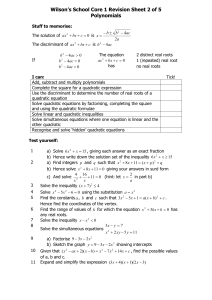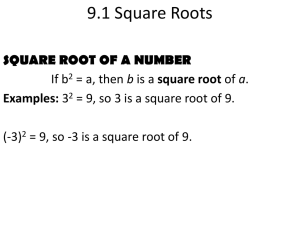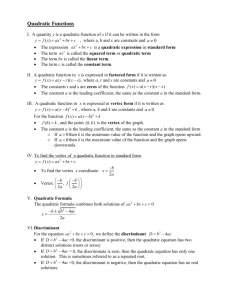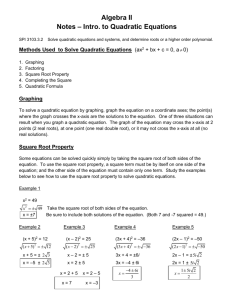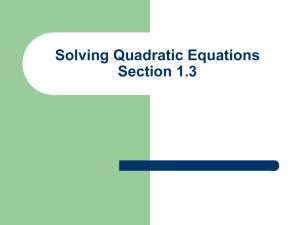The Quadratic Formula
advertisement
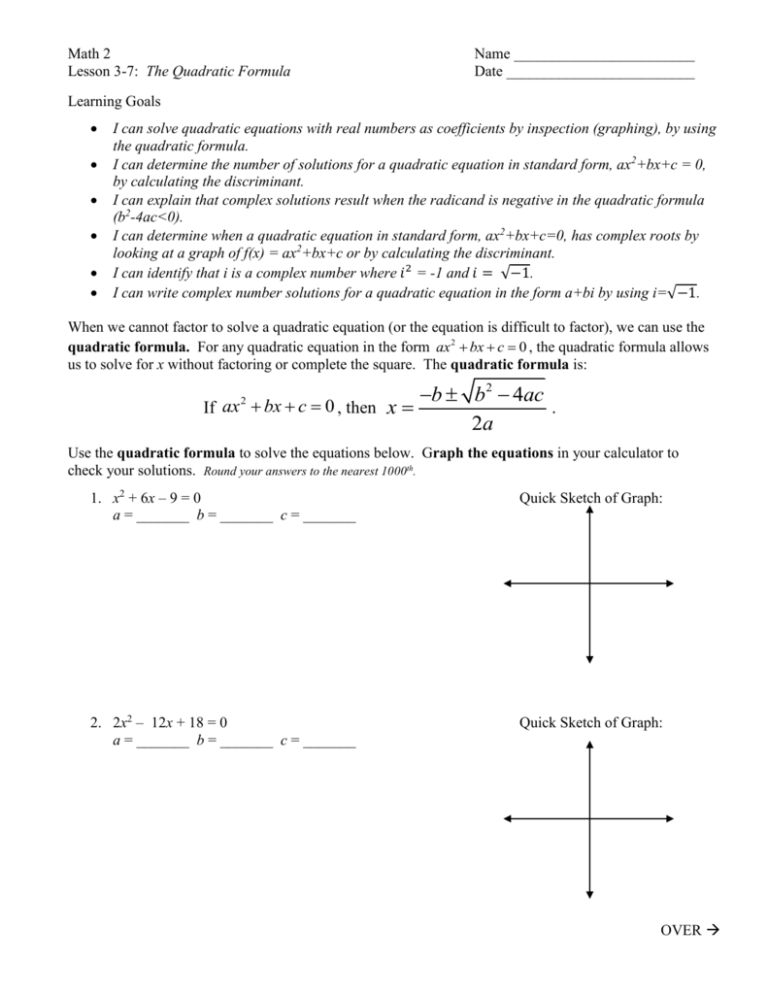
Math 2 Lesson 3-7: The Quadratic Formula Name ________________________ Date _________________________ Learning Goals I can solve quadratic equations with real numbers as coefficients by inspection (graphing), by using the quadratic formula. I can determine the number of solutions for a quadratic equation in standard form, ax2+bx+c = 0, by calculating the discriminant. I can explain that complex solutions result when the radicand is negative in the quadratic formula (b2-4ac<0). I can determine when a quadratic equation in standard form, ax2+bx+c=0, has complex roots by looking at a graph of f(x) = ax2+bx+c or by calculating the discriminant. I can identify that i is a complex number where 𝑖 2 = -1 and 𝑖 = √−1. I can write complex number solutions for a quadratic equation in the form a+bi by using i=√−1. When we cannot factor to solve a quadratic equation (or the equation is difficult to factor), we can use the quadratic formula. For any quadratic equation in the form ax 2 bx c 0 , the quadratic formula allows us to solve for x without factoring or complete the square. The quadratic formula is: b b2 4ac If ax bx c 0 , then x . 2a 2 Use the quadratic formula to solve the equations below. Graph the equations in your calculator to check your solutions. Round your answers to the nearest 1000th. 1. x2 + 6x – 9 = 0 a = _______ b = _______ c = _______ Quick Sketch of Graph: 2. 2x2 – 12x + 18 = 0 a = _______ b = _______ c = _______ Quick Sketch of Graph: OVER Page 2 3. 0 = 20 – 6x + 3x2 a = _______ b = _______ c = _______ I. Where does the Quadratic Formula come from? Quick Sketch of Graph: http://www.youtube.com/watch?v=GRluUxorUvU What process is used to derive the formula? _________________________________ What is the first step of the proof? __________________________________ In order to add the fractions on the right side of the equations, what must be the same? __________________________________ When square-rooting both sides of the equation, what must go in front of the square root symbol? ___________ What does √4𝑎2 equal? ___________ II. Additional uses of the Quadratic Formula: A. How to find the axis of symmetry and the vertex of the parabola: The quadratic formula can be split into two separate parts: x b b2 4ac 2a 2a Consider the parabola whose equation is x 2 4 x 5 0 . Here is its graph: What is the equation of its axis of symmetry? _________ What are the coordinates of its vertex? _________ Now use the values from the equation to calculate b . 2a What do you notice? What are the coordinates of the x-intercepts? ____________ Use the values from the equation to calculate What does the result tell you about the graph? _____________ b 4ac . 2a 2 Page 3 B. How to predict the types of solutions to a quadratic equation: In problems 1 through 3, we discovered that when finding the solutions of a quadratic function there were different types of solutions. List the different types of possible solutions that you discovered for a quadratic function: A way to find out the type of solution(s) of quadratic function before using the quadratic formula is to calculate the discriminant ( b 2 4ac ). 1. a. Calculate the discriminant for problem 1. b. If the discriminant is ___________________ (positive, negative, or zero), then there is/are ____________ solution(s). 2. a. Calculate the discriminant for problem 2. b. If the discriminant is ___________________ (positive, negative, or zero), then there is/are ____________ solution(s). 3. a. Calculate the discriminant for problem 3. b. If the discriminant is ___________________ (positive, negative, or zero), then there is/are ____________ solution(s). OVER Page 4 III. Imaginary Numbers In problem #3, we found that the equation had no solutions due to the fact that we could not take the square root of a negative number. Historically speaking, though, mathematicians were not satisfied with the idea that an equation could not be solved. In order to solve this dilemma a new number set was invented – called the Imaginary Numbers. Consider the equations: 1. Graph each equation to find the x-intercepts. 2. x2 – 9 = 0 x2 + 9 = 0 Now solve each equation for x. 3. How many solutions does each have? NOTES: Examples: Solve the following equations. 1. x 2 225 2. 4 x 2 200 3. 3x 2 9 90 4. 0 = 20 – 6x + 3x2 Page 5 OVER HOMEWORK Copy each problem on another sheet of paper & show all work. 1. Solve each equation by using the Quadratic Formula. Exact answers only. g. -16x2 + 45x + 6.5 = 0 h. -16x2 + 40.2x + 8.6 = 0 2. For each function do the following: Use concepts from this lesson to find the axis of symmetry. Use concepts from this lesson to find the vertex. a. h(t) = -16t2 + 45t + 6.5 b. y = .05x2 – 1.2x c. y = x2 – 10x + 14 ***After you have found the vertex for the equation in c, rewrite it in vertex form using the completing the square technique. Does the result verify your computations? If not, check your work and make corrections. 3. Solve the following equations. a. x2 = -64 b. x2 + 100 = 0 c. -2x2 = 50 d. x2 + 40 = -63 e. 7x2 + 10 = -5 f. -80 = 4x2 4. For each equation do the following: Calculate the discriminant. Based on the discriminant, solve the equation by either factoring or the quadratic formula. a. x2 + 7x + 10 = 0 b. 2x2 – 7x – 10 = 0 c. 3x2 – x + 14 = 0 d. x2 – 4x = 13 e. 4x2 + 12x – 9 = -18 f. x2 + 9x = 0

